

You are using an out of date browser. It may not display this or other websites correctly.
You should upgrade or use an alternative browser.
You should upgrade or use an alternative browser.
Egyptian Wheat
- Thread starter Guest
- Start date
-
- Tags
- None
Daver
PMA Member
This question is to anyone, maybe even be speculative...
Do you think EW mixed with sorghum would provide good bedding cover if planted in blocks (one acre or more)?
I would think so, but many people have told me that while switchgrass is a good bedding cover you have to have a decent sized field of it before they use it much. Something like 8-10 acres or more, so I am not sure if one acre of EW would pan out or not, but I sure wouldn't want to be near it if it caught on fire!!!!
So if you did plant a block of it I would certainly make sure to consider healthy fire breaks! I am going to plant more EW next year than I did this year. (I just have one row of it now.) Even with our very dry summer the EW grew reasonably well, it is probably an average of 6' tall right now and I got it in a little later than what I should have.
Hardwood11
It is going to be a good fall!
I think it would be very attractive for bedding in more open country! It might not be that appealing in Southern Iowa. In my area of MN, SD, ND, Nebraska, Kansas. 2-5 acres of it would be dynamite (my opinion). I planted two acres of sorghum a few years ago, and I had two 140 inch bucks bedding in it for a month.
I'll be testing this out the next two to three years.
I'll be testing this out the next two to three years.
dbltree
Super Moderator
September 11th, 2012
Egyptian Wheat (a type of sorghum not wheat) is definitely very drought resistant and while it does need some rainfall obviously can get by with very little...this being some of the shorter EW we have this year on high ground.
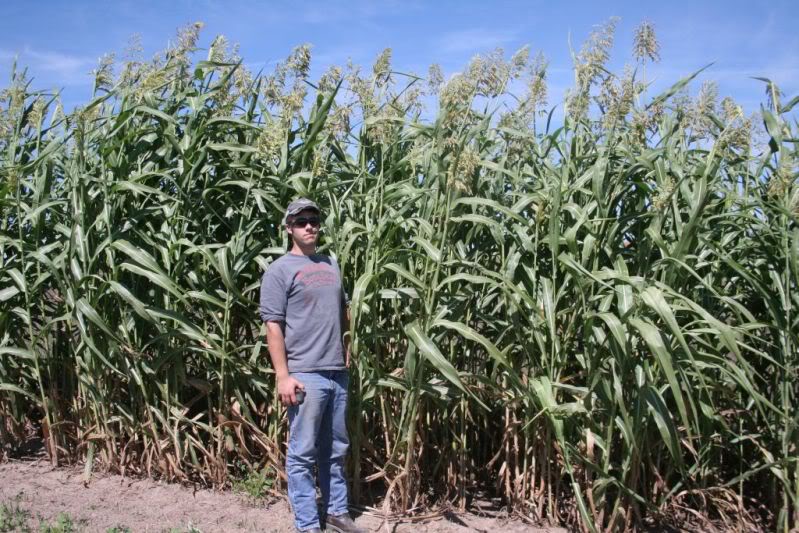
Where planted in sandy soils or next to trees, the EW can of course fail altogether during a drought year but given any moisture along with plenty of nitrogen (we use 100#'s urea per acre) it can reach incredible heights such as this EW planted in rich lowland soils
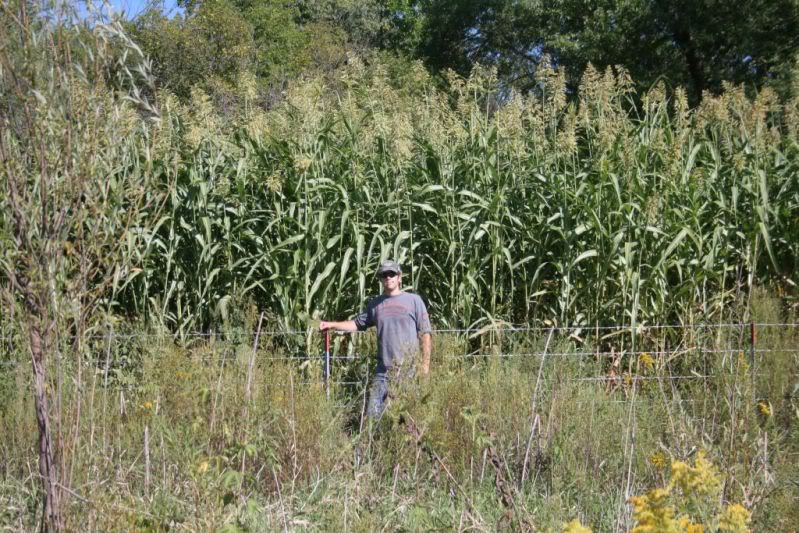
nearly every feeding area for which I am responsible is screened with Ew
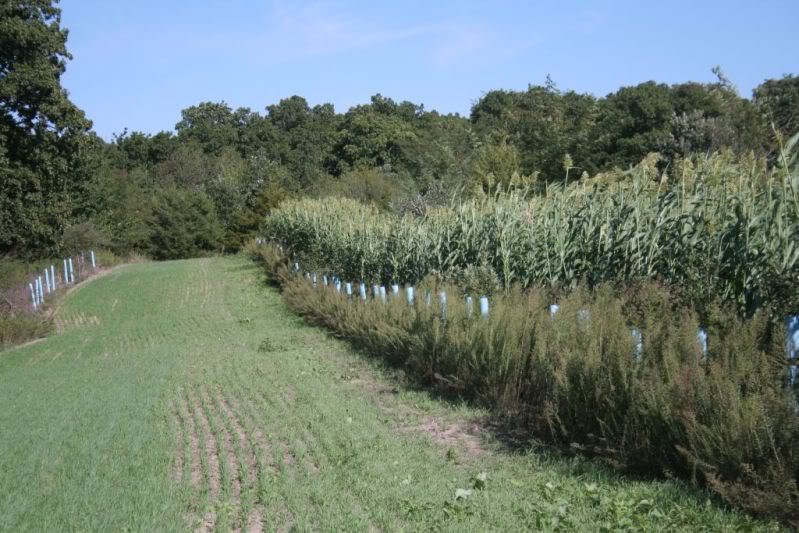
and there is a marked increase in daytime deer movement/feeding activity because of this
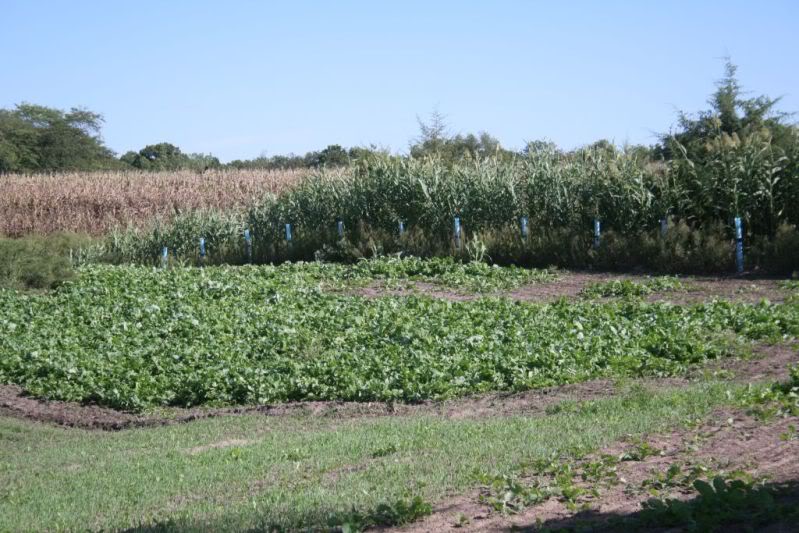
the screens also become travel corridors even though they can travel thru them, they rarely do preferring instead to follow the edge
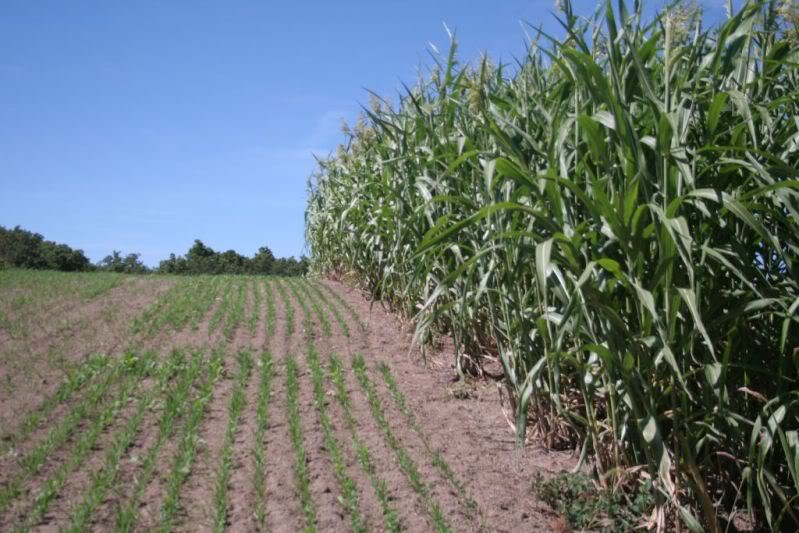
Entire fields are easily screened from the road virtually eliminating road poaching incidents
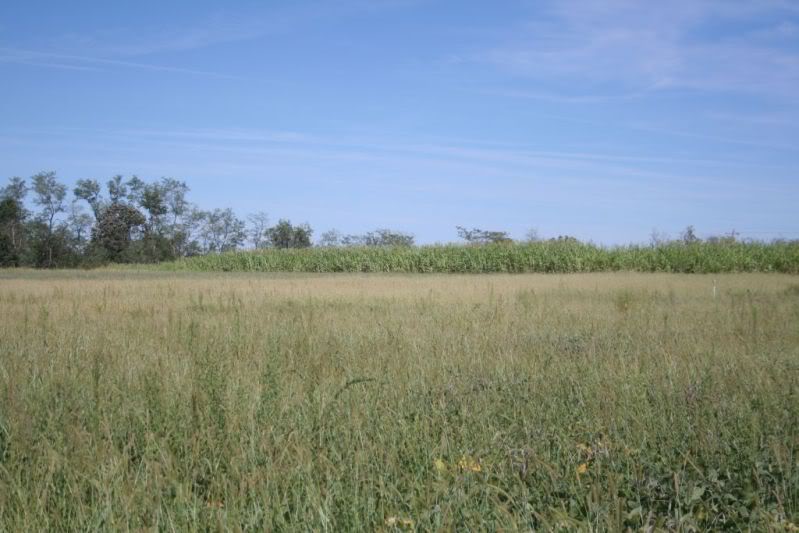
EW screens can provide access to blinds without concerns of spooking deer while entering and exiting the stands
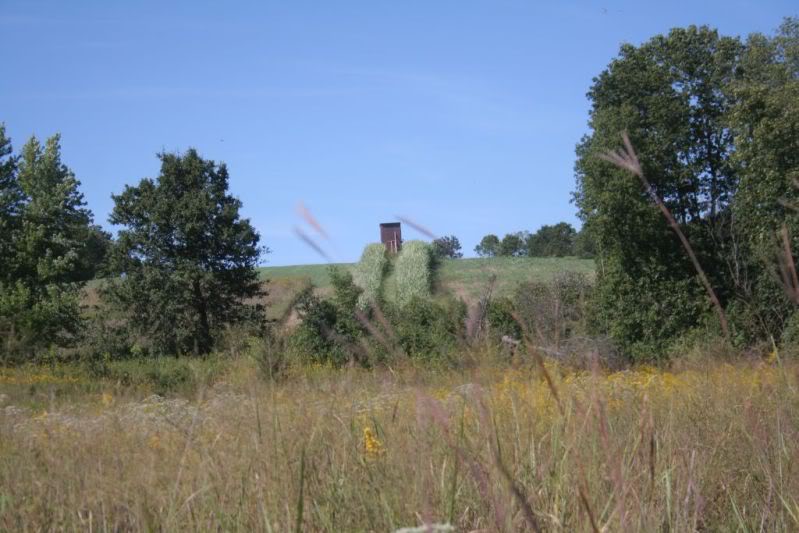
Create an opening in front of the blind and every deer will travel thru it, making harvesting deer at close range a reality
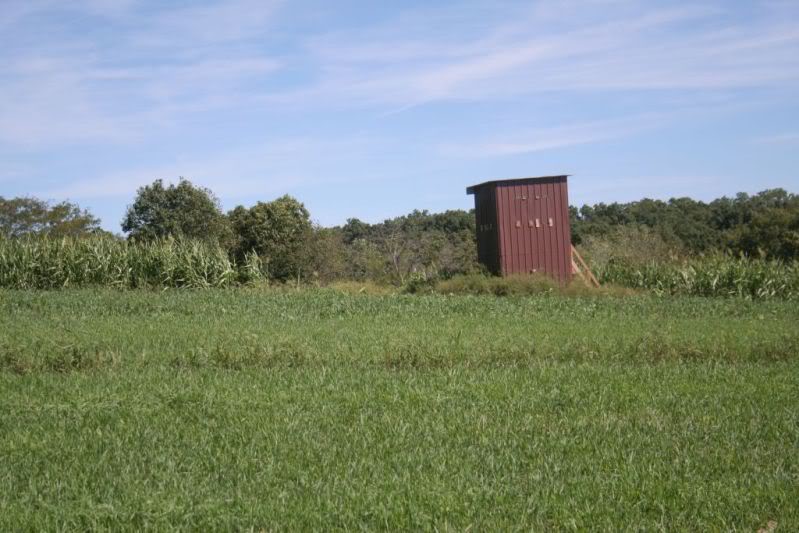
6#'s per acre along with 100#'s of urea per acre make planting EW an economical means of effectively screening your plots and farm...easily planted in late May to early June in a 5-8' wide strip...no good reason not to take advantage of this annual crop but, consider planting conifers along side the strips for permanent screens....
Egyptian Wheat (a type of sorghum not wheat) is definitely very drought resistant and while it does need some rainfall obviously can get by with very little...this being some of the shorter EW we have this year on high ground.

Where planted in sandy soils or next to trees, the EW can of course fail altogether during a drought year but given any moisture along with plenty of nitrogen (we use 100#'s urea per acre) it can reach incredible heights such as this EW planted in rich lowland soils

nearly every feeding area for which I am responsible is screened with Ew

and there is a marked increase in daytime deer movement/feeding activity because of this

the screens also become travel corridors even though they can travel thru them, they rarely do preferring instead to follow the edge

Entire fields are easily screened from the road virtually eliminating road poaching incidents

EW screens can provide access to blinds without concerns of spooking deer while entering and exiting the stands

Create an opening in front of the blind and every deer will travel thru it, making harvesting deer at close range a reality

6#'s per acre along with 100#'s of urea per acre make planting EW an economical means of effectively screening your plots and farm...easily planted in late May to early June in a 5-8' wide strip...no good reason not to take advantage of this annual crop but, consider planting conifers along side the strips for permanent screens....
Saving Seeds
Can you tell me (us) about when we should start looking to cut the seed heads off if we are looking to use them for next Spring please? And if there is any process associated with this? Sorry if this has been covered before, I'm ok with "RTM" if that's the case
Thanks!
Can you tell me (us) about when we should start looking to cut the seed heads off if we are looking to use them for next Spring please? And if there is any process associated with this? Sorry if this has been covered before, I'm ok with "RTM" if that's the case
Thanks!
dbltree
Super Moderator
Any recommendations on what can be planted with EW to help it stay standing?
Minimum recommended width privacy?
I planted it this and I am so happy with the results. Been looking for something like this for years. Thanks for the heads up..
5' to 8' feet wide is usually plenty and usually it stays standing pretty well on it's own so I have never mixed anything with it other then grain sorghum (milo) for upland birds
5' to 8' feet wide is usually plenty and usually it stays standing pretty well on it's own so I have never mixed anything with it other then grain sorghum (milo) for upland birds
Great forum and very informative discussion!!
Dbltree, when tilling it in (after chopping), is it possible to plant the same strips year after year? I am thinking of lining my plot strips and trails and dont want to be without the screening the following year.
Thanks!
dbltree
Super Moderator
Great forum and very informative discussion!!
Dbltree, when tilling it in (after chopping), is it possible to plant the same strips year after year? I am thinking of lining my plot strips and trails and dont want to be without the screening the following year.
Thanks!
I try to avoid planting it more then two years in a row in same strip. I just leave a total of 10/15' and rotate half to something else each year.
dbltree
Super Moderator
December 12th, 2012
Most of our Egyptian Wheat is holding up well....
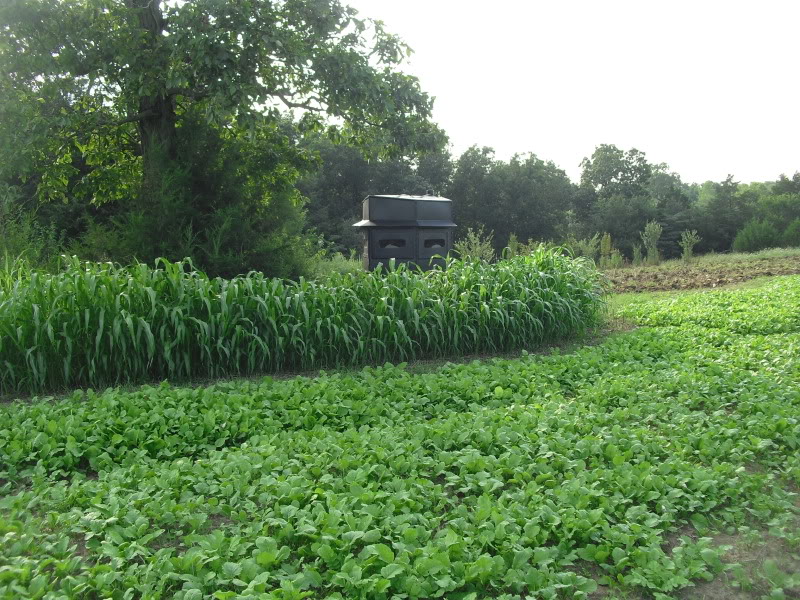
High winds have started to break a few stalks over but the screens are still very effective
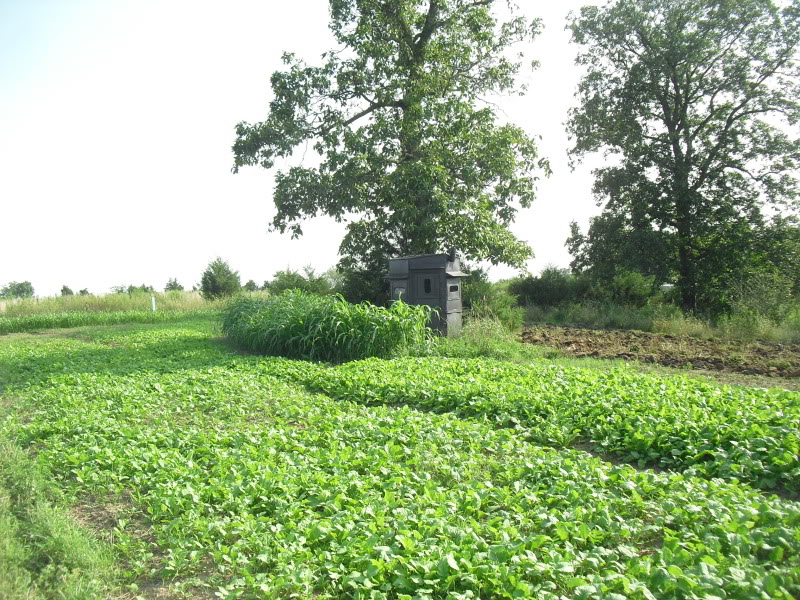
Though very drought resistant the late planted EW broke down quickly, apparently ending up with very weak stalks so late May plantings were far better then late June this year. So far most of the stands are holding up well
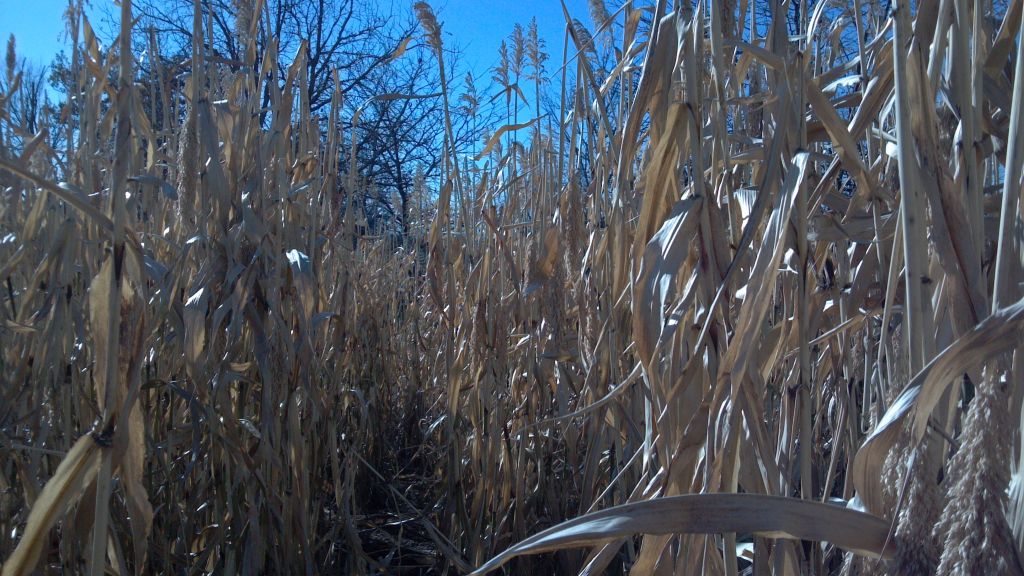
Often there are well worn runways along the hidden side of the EW and deer adapt to coming thru an opening either cut or left unplanted which brings them by a stand or blind
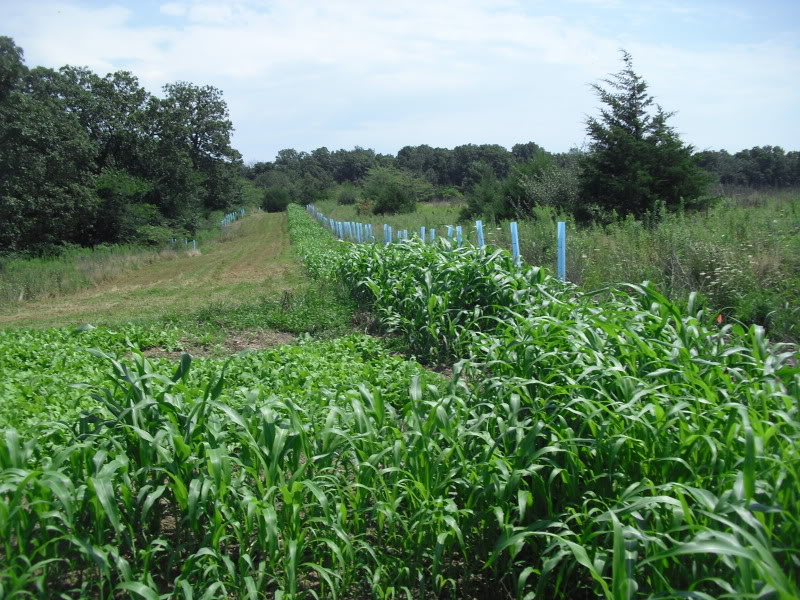
Though not shown in these pics I have been adding some milo seed to the EW, both for upland birds and for late season deer feed. It seems to grow well with the tall EW and is just a way to add some additional food for wildlife in general. WGF sorghum (Wild Game Food) or the short grain sorghum mix from Pheasants Forever are all great options to mix in 2-3#'s per acre.
The more I use EW the more uses I find for it, including poacher screens, plot screens, creating funnels, approaches to blinds and tree stands and the list goes on. Plant at 6-8#'s per acre with 100#'s of nitrogen in late May and use it to compliment your habitat program....

Most of our Egyptian Wheat is holding up well....

High winds have started to break a few stalks over but the screens are still very effective

Though very drought resistant the late planted EW broke down quickly, apparently ending up with very weak stalks so late May plantings were far better then late June this year. So far most of the stands are holding up well

Often there are well worn runways along the hidden side of the EW and deer adapt to coming thru an opening either cut or left unplanted which brings them by a stand or blind

Though not shown in these pics I have been adding some milo seed to the EW, both for upland birds and for late season deer feed. It seems to grow well with the tall EW and is just a way to add some additional food for wildlife in general. WGF sorghum (Wild Game Food) or the short grain sorghum mix from Pheasants Forever are all great options to mix in 2-3#'s per acre.
The more I use EW the more uses I find for it, including poacher screens, plot screens, creating funnels, approaches to blinds and tree stands and the list goes on. Plant at 6-8#'s per acre with 100#'s of nitrogen in late May and use it to compliment your habitat program....

Barrett's Dad
Member
Dbltree - what types of trees do you have planted in the Tubes that run along your EW screens?
dbltree
Super Moderator
Dbltree - what types of trees do you have planted in the Tubes that run along your EW screens?
Dwarf Chinkapin, BurXEnglish and BurXGambel hybrid oaks..planted as a source of sweet low tannin acorns. On the other side of the EW are red cedars, some natural and others we are hand planting there to make a permanent screen :way:
Welter 2013 Seed Guide
I just got Welter Seed's 2013 Seed catalog and am looking at all the options available for Sorghum and Sorghum-Sudan hybrids. Does anyone have any recommendations from the catalog? Only one of them mentions height, the Redtop Plus at 7-9'. I use it exclusively as a screen. I'll call and see what they recommend as well.
This last summer I used a mix of Egyptian Wheat and Rox Orange Forage Sorghum. Where i planted them both on time, they are both holding up well thus far, but the Rox Orange came in taller but not as stout as the EW. Where I planted them both late, a lot of it isn't as sturdy and had blown over in the 30-40 mph wind storms we had a few weeks ago. Not complaining, just informing. It all worked and worked well, in fact too well in some areas where it grew taller than my blinds where made for and I had to knock some down a little
I just got Welter Seed's 2013 Seed catalog and am looking at all the options available for Sorghum and Sorghum-Sudan hybrids. Does anyone have any recommendations from the catalog? Only one of them mentions height, the Redtop Plus at 7-9'. I use it exclusively as a screen. I'll call and see what they recommend as well.
This last summer I used a mix of Egyptian Wheat and Rox Orange Forage Sorghum. Where i planted them both on time, they are both holding up well thus far, but the Rox Orange came in taller but not as stout as the EW. Where I planted them both late, a lot of it isn't as sturdy and had blown over in the 30-40 mph wind storms we had a few weeks ago. Not complaining, just informing. It all worked and worked well, in fact too well in some areas where it grew taller than my blinds where made for and I had to knock some down a little
dbltree
Super Moderator
In Egyptian Wheat screens not along a road we added some short milo mixes, in this case from Pheasants Forever
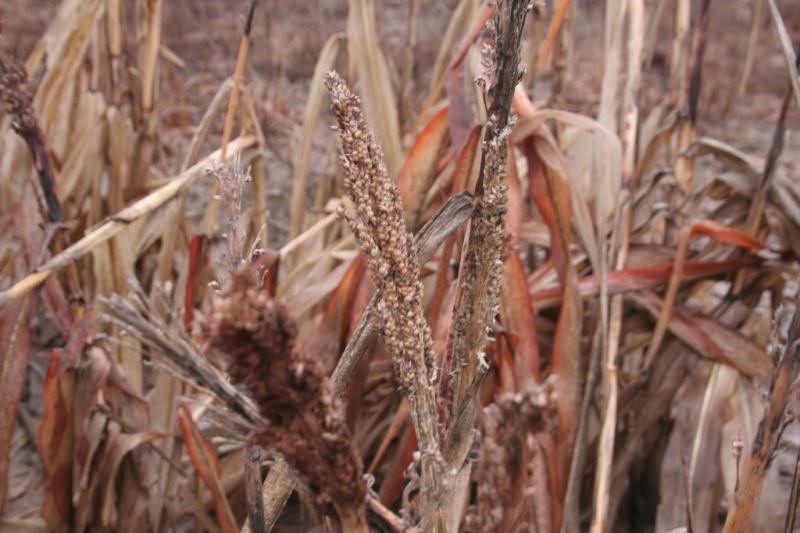
Whitetails and both song and game birds feed on the grain heads so it makes a nice combination
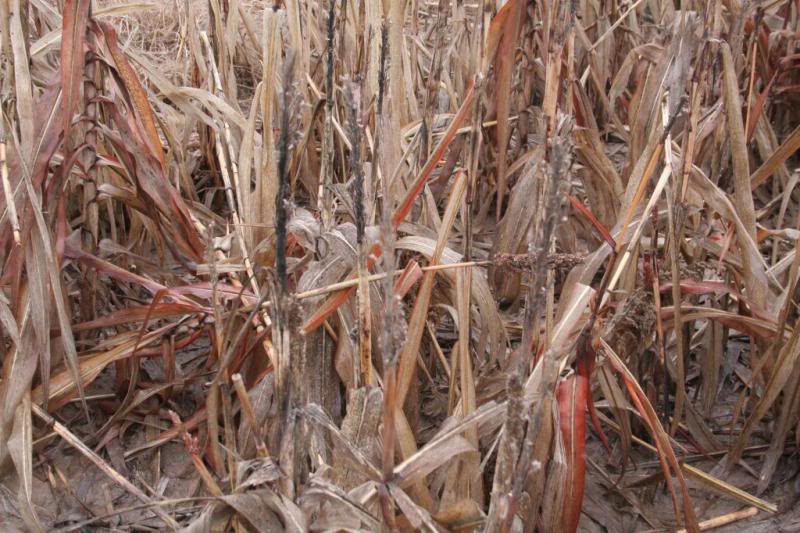
Most of the screens are pretty well "kaput" at this point but still provide some late winter small game cover
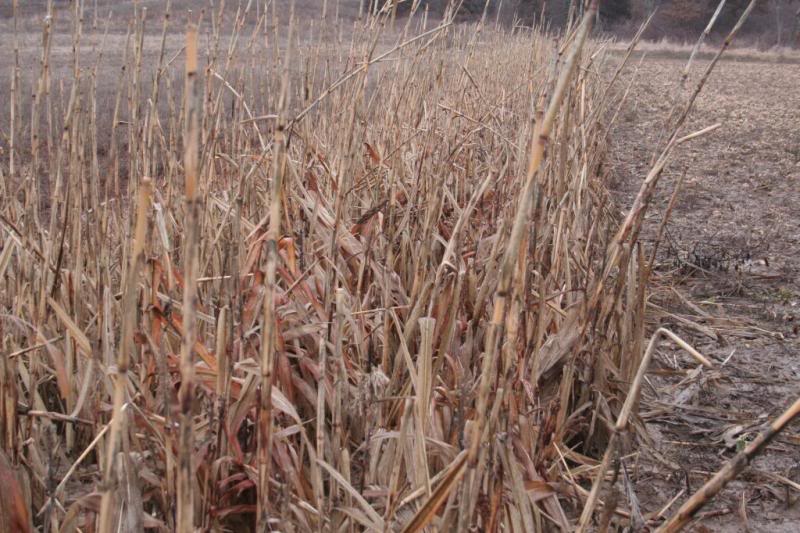
Someone mentioned concerns about Egyptian Wheat seed availability due to the 2012 drought but if you can not find seed, the following are two sources who both have seed and will ship in small quantities.
Iowa-Missouri Hybrids - Aaron Palm cell# 641-919-1695
Northwoods Whitetails - John Komp (906) 863 9383
EW is a warm weather crop and we usually plant late May/early June in SE Iowa but it might not hurt to get your seed ordered now to be sure it's ready when you are. 6-8#'s per acre along with 100#'s of urea makes for a cheap but effective screen... :way:

Whitetails and both song and game birds feed on the grain heads so it makes a nice combination

Most of the screens are pretty well "kaput" at this point but still provide some late winter small game cover

Someone mentioned concerns about Egyptian Wheat seed availability due to the 2012 drought but if you can not find seed, the following are two sources who both have seed and will ship in small quantities.
Iowa-Missouri Hybrids - Aaron Palm cell# 641-919-1695
Northwoods Whitetails - John Komp (906) 863 9383
EW is a warm weather crop and we usually plant late May/early June in SE Iowa but it might not hurt to get your seed ordered now to be sure it's ready when you are. 6-8#'s per acre along with 100#'s of urea makes for a cheap but effective screen... :way:
dbltree
Super Moderator
Paul we have some seed left over from last year. Will it still germinate?
You bet! Usually very high germ 2nd year
Hardwood11
It is going to be a good fall!
bedding
I will be experimenting with blocks of E Wheat this year as bedding cover. A second benefit will be pheasants love it!
My plan is to plant a block of 2-3 acres in open country (few tall trees...mostly CRP and cattail/shrubby cover)
I will mix in some sorghum...the mix is called Plot Screen by Frigid Forage.
Last year we saw some bedding activity on a small narrow plot, so I believe if expanded it will be a bedding area.
I'll have to stay out of it until late season for pheasants
Cameras on the edge with a trail mowed down the middle will determine activity....should be a fun experiment.
I will be experimenting with blocks of E Wheat this year as bedding cover. A second benefit will be pheasants love it!
My plan is to plant a block of 2-3 acres in open country (few tall trees...mostly CRP and cattail/shrubby cover)
I will mix in some sorghum...the mix is called Plot Screen by Frigid Forage.
Last year we saw some bedding activity on a small narrow plot, so I believe if expanded it will be a bedding area.
I'll have to stay out of it until late season for pheasants
Cameras on the edge with a trail mowed down the middle will determine activity....should be a fun experiment.